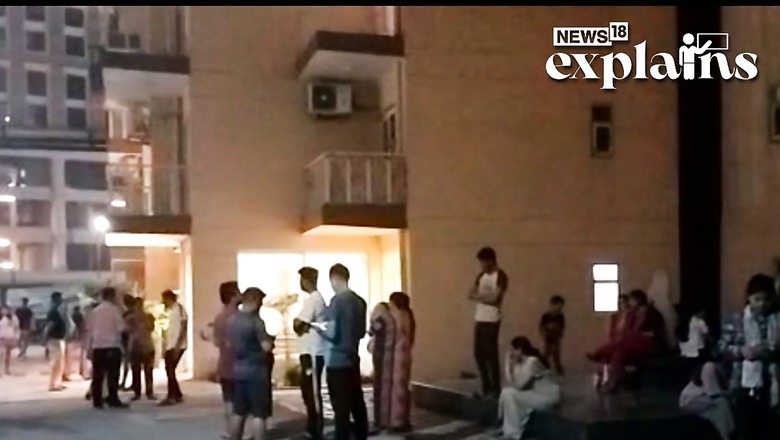
views
Strong tremors jolted large swathes of north India, including Delhi-NCR, on Tuesday night as an earthquake of magnitude 6.6 struck the Hindu Kush region in Afghanistan. People rushed out of their homes and came out on the streets as the powerful temblor shook the mountainous region at 10.17 pm. There was no immediate report of any loss of life or damage to property.
According to the National Centre for Seismology (NCS), the epicentre of the earthquake was 133 km south-southeast of Fayzabad in Afghanistan with a focal depth of 156 km.
In India, the earthquake was felt across northern region, including Delhi-NCR, Jammu and Kashmir, Haryana, Punjab, Himachal Pradesh, Uttarakhand and Rajasthan.
#WATCH | Uttar Pradesh: People rush out of their houses to open spaces as several parts of north India experience strong tremors of earthquake. Visuals from Golf City, Noida. pic.twitter.com/Y5GmK1Ck2S
— ANI (@ANI) March 21, 2023
A resident in Rajasthan’s Sri Ganganagar district said he felt three tremors back to back.
But why did people in North India feel the earthquake in Afghanistan with such intensity? News18 Explains:
The Reasons Why
A senior seismologist said the reason why people in northwest India and Delhi felt the tremors for a relatively longer time is because the “depth of the fault was more than 150 km“.
As per a report by Indian Express, according to the United States Geological Survey (USGS), the earthquake was deep, with its origin 187.6 kilometres beneath the earth’s surface. Intense earthquakes are typically felt across long distances, which explains why tremors were detected in Punjab, Rajasthan’s Jaipur, and Jammu & Kashmir, the report says.
USGS explains that earthquakes occur in the crust or upper mantle, which extends from the earth’s surface to around 800 kilometres below the surface (about 500 miles).
Because the strength of shaking from an earthquake decreases with increasing distance from the source, the strength of shaking at the surface from an earthquake that occurs at 500 km depth is significantly less than if the same earthquake occurred at 20 km depth.
Deep earthquakes happen within the cores of subducting slabs, which are oceanic plates that drop into the Earth’s mantle from convergent plate boundaries, where a thick oceanic plate collides with a less dense continental plate and falls beneath the latter. The plate boundary contact between two such plates produces very big, shallow subduction zone earthquakes, such as the Sumatra 2004 M9.1 event and the Japan 2011 M9.0 earthquake, and is only active to very shallow depths – roughly 60 km, the USGS explains.
#Earthquake #Noida NCR #Delhi pic.twitter.com/oTSeAsa2LB— Vinod Kapri (@vinodkapri) March 21, 2023
Yet, because oceanic slabs in deeper subduction zone conditions are relatively cold in comparison to the surrounding mantle, faults inside the core of these slabs remain brittle and can create earthquakes to depths of up to 700 km (e.g., Pacific Plate beneath Japan and Kamchatka, and beneath Tonga).
Do Shallow Earthquakes Cause More Damage?
Shallow earthquakes are more destructive in general because they carry more energy when they reach the surface. Deeper earthquakes lose a lot of energy by the time they reach the surface, explains the Indian Express report. Deeper quakes spread farther — seismic waves flow radially upwards to the surface — even though they lose energy as they travel farther and hence do less damage. As a result, the recent tremors are unlikely to cause significant damage in India.
This earthquake had a magnitude of 6.5. The magnitude of the waves relates to their size, whereas the strength refers to the amount of energy they carry. Because magnitude is defined on a logarithmic scale, seismic waves produced by a magnitude 6 earthquake have ten times the amplitude of seismic waves produced by a magnitude 5 earthquake. The energy differential is significantly greater, 32 times for every magnitude shift, the report says.
What Impact Did India Face?
People in northern India first felt the primary waves and then were impacted by the secondary waves, he said. According to the NCS, the epicentre of the earthquake was located at 36.09 degrees north on the latitude and 71.35 degrees east on the longitude with a focal depth of 156 km.
There were disruptions in mobile services in some parts of the Jammu region immediately after the earthquake, an official said.
In east Delhi’s Shakarpur, anxious people filled the congested lanes after claims by some that a building had tilted, but it turned out to be a false alarm. Two fire tenders were rushed to south-east Delhi’s Jamia Nagar after a call claimed that a building was leaning there, officials said, adding further information is awaited.
Delhi Chief Minister Arvind Kejriwal tweeted, “Strong tremors were felt across Delhi-NCR. Hope you all are safe.” A Noida resident said he first noticed the dining table shaking. “Soon after we saw that the fans were also shaking. The earthquake was strong in terms of intensity and stayed for a relatively longer period,” the resident of Hyde Park society in Noida said.
A cab owner in Delhi said he felt the earthquake while he was waiting for passengers.
“I was waiting for passengers and suddenly my car started shaking. I immediately shouted and alerted my friends,” said cab owner Ramesh Pawar, who was near Connaught Place in central Delhi.
Jyoti, a resident of Lajpat Nagar in south Delhi, said she was watching television when she suddenly saw the TV and sofa were shaking. Initially, she ignored it but when her husband alerted her, she and her family members rushed out of their home.
“I ignored it initially but as soon as my husband alerted, I felt the earthquake too. This time it was strong and the sofa I was sitting on started shaking a bit. We rushed outside our home. Thankfully, we are on the ground floor, so in such situations, we have an easy escape,” she said.
Ghaziabad-resident Inderjeet Kaur said, “We felt the tremors for nearly 30 seconds and rushed out of our home.” Jagdish Patwal, a resident of a high-rise apartment building in Noida, said, “The sofa, fan were shaking and people climbed down from the 20th floor.” Chatter about the possible epicentre of the earthquake and memories of the destruction caused by a series of temblors in Turkiye dominated the discussions in the groups of people who rushed out of their homes.
The tremors also sparked panic in Rajasthan as people rushed out of buildings as a precautionary measure and enquired about the earthquake from others.
In Punjab and Haryana and their common capital Chandigarh, people rushed out of their homes during the tremors.
“I was about to go to sleep when I suddenly felt a strong tremor. I along with my wife and two children rushed downstairs,” said Ajay Kumar, who lives on the third floor of a residential society in Chandigarh.
In Zirakpur, a town in Punjab which is on the outskirts of Chandigarh and has many high-rise residential societies, panic-stricken people rushed out of their homes and gathered in open parks.
Reports from many places in Punjab, including Pathankot, Mohali, Jalandhar, Phagwara and Ludhiana, said strong tremors were felt.
There were similar reports from many places in Haryana, including Panchkula, Ambala, Karnal and parts of the National Capital Region. In Himachal Pradesh, people in Shimla, Mandi and several other places rushed to safety.
With inputs from PTI
Read all the Latest Explainers here


















Comments
0 comment